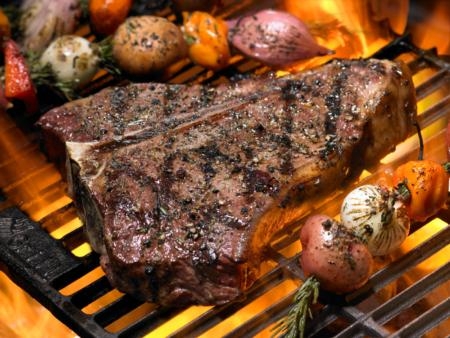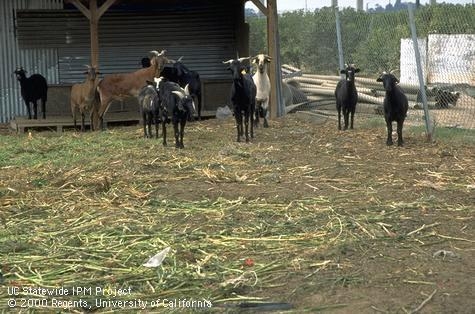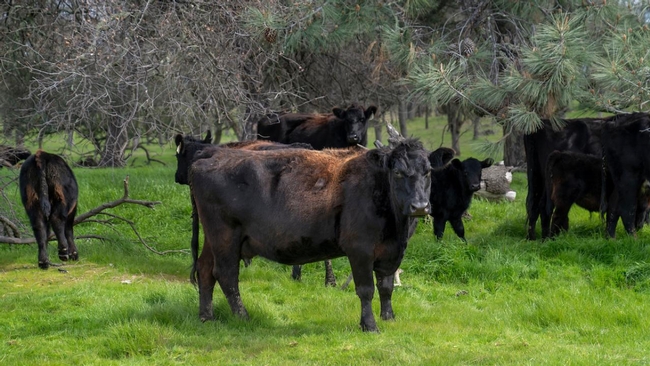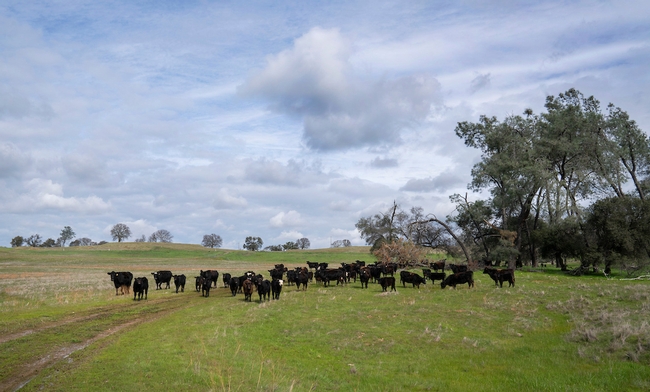
Posts Tagged: meat
California’s local meat suppliers struggle to stay in business
UC Davis report suggests ways to build resilience
The University of California, Davis, Food Systems Lab has released a white paper showing the need to support California's small and mid-scale meat suppliers and processors in order to build a more resilient meat supply chain. It describes how the meat supply chain and rural economies could benefit from regulatory changes and more collaboration among producers and other stakeholders in the system.
The pandemic shut down meat processing plants in 2020, as did recent ransomware attacks on JBS, the nation's largest meat supplier. Report authors said this highlights the need to support small- and mid-scale suppliers.
“COVID and the ransomware attacks put a spotlight on how the concentration of the meat supply chain increased vulnerability in the food system,” said report co-author Tom Tomich, founder of the UC Davis Food Systems Lab and distinguished professor in the Department of Environmental Science and Policy. “We need to level the playing field so small- and mid-scale farms have an easier way to bring their product to market.”
The report says the lack of access to slaughter facilities, limited capacity of cut and wrap facilities, and concentration of marketing channels create conditions in which small- and mid-scale farms and ranches struggle to stay in business.
“These challenges are exacerbated by policies that tilt the playing field against small operators. Fortunately, new state and national legislation and programs are developing that could increase resilience in our food systems,” says Michael R. Dimock, Roots of Change program director and lead author for the report. “We need cities and counties to help fix the problems because local land use policies often impede development of resilient supply chains.”
Lack of access and limited capacity
Smaller ranchers in California have limited access to slaughter and processing facilities. In the last 50 years, California has lost half of its federally inspected meat processing plants, and the remaining facilities are unable to meet demand. Many of the 46 USDA-certified slaughter plants operating in California are closed to smaller producers.
“This means that smaller ranchers must drive hundreds of miles to reach a facility or have to wait months due to limited capacity,” said Tomich.
The report said a combination of federal, state and private investments could provide a broader geographic distribution of plants of differing scales. It also suggests expanding mobile, on-farm slaughter operations for sheep, goats and hogs, similar to those for beef.
Regulatory barriers and opportunities
Complex inspection requirements and other regulatory barriers make it difficult for small- and mid-scale producers to compete with big suppliers. The report suggests California create its own meat inspection program equivalent to the federal program to serve smaller ranchers. Prioritizing public procurement of local, high-value meat would also help expand market access for smaller producers.
Broader benefits of smaller operators
The report notes other beneficial roles of small- and mid-scale livestock operations, apart from the potential to increase resilience in our food system. Livestock grazing is a cheap and effective way to reduce wildfire risk. Supporting local meat processing also helps rural economies and creates community-based jobs.
The report was based on 27 interviews with people representing a wide spectrum of activities and points of view within the meat supply chain throughout the state. Authors are Courtney Riggle, Allan Hollander, Patrick Huber and Thomas Tomich of the UC Davis Food Systems Lab, and Michael R. Dimock with Roots of Change.
Funding for the study came from the TomKat Foundation and USDA Hatch Program.
Docs ask: Does “do no harm” apply to food served in hospitals?
“First, do no harm” is a core tenet taught to aspiring medical professionals. In June this year, the Sustainability Task Force of the UCSF Academic Senate drafted a resolution asking UCSF food services to phase out of all procurement of meat produced with the use of non-therapeutic antibiotics. Given that many scientists believe that the use of prophylactic antibiotics for livestock production causes antibiotic resistance, how can physicians stand by while hospitals serve foods from antibiotic-treated animals to patients that increasingly suffer from antibiotic-resistant infections? If not, what can they do about it?
In a few weeks, local organizations will take up the hard questions again with their peers at UCSF Medical Center. Going beyond meatless Mondays, healthcare professionals, Healthcare Without Harm, and PEW Charitable Trusts, all see antibiotic-free meat and poultry as the next step in advocating for healthier food.
Fixing this problem for most of us is as simple as buying organic meat or free-range antibiotic-free alternatives. For a UC medical center, however, it is far from simple. Price, supply and food budgets are all based on past purchase history. It takes considerable will, consensus, and commitment to “do no harm” before administrators will agree to pay double or triple the cost for meat produced without these drugs. Cattle fed regular antibiotics to fatten them up, even when they are healthy, are more profitable up the entire food chain.
The advocates for the healthcare side want to know: Can this become a priority for us and our hospitals? Where are the suppliers of antibiotic-free products? Are they selling the cuts we need? How can change be “phased in” to allow the distribution chain to supply this emerging demand? In a hospital, should food be one of the least expensive of many pricey services?
The producers are likely to have questions, too. Is this a lucrative opportunity for smaller alternative suppliers, or is it a political battle to force big agriculture to comply? If producers start down this road, how many bumps will they encounter along the way? Why should they risk supplying a new market when business is risky as is? How long will they commit to these products?
It seems logical that low production costs alone should not threaten the public health of a nation or even just the health of the nation's vulnerable citizens. If these drugs were never allowed for feeding in the first place, producers would be on a level playing field and beef might be more than a commodity. Likewise, ethical food standards have defined humanity for thousands of years. So now that there is more food, more technology and more choice, why is it more difficult to make changes that ultimately benefit everyone?
More information:
The Sustainability Committee of the UC San Francisco Division of UC Academic Senate June 2013 resolution includes a link to a bibliography.
Health Care Without Harm is an international coalition of 500 organizations in 53 countries working to transform the health care sector, without compromising patient safety or care, so that it is ecologically sustainable and no longer a source of harm to public health and the environment.
San Francisco Bay Area Physicians for Social Responsibility, Healthy Food in Health Care Program. 510-559-8777
Photo by Keith Weller, USDA, ARS, Photo Library
eXtension helps small-scale meat producers find processors
A national network for niche meat processors is being developed by eXtension to connect small-scale meat producers across the country with information, tools and each other, reported Food Safety News.
The Niche Meat Processors Assistance Network (NMPAN) was launched three years ago by co-coordinators Lauren Gwin of Oregon State University and Arion Thiboumery of Lorentz Meats of Minnesota.
"I was working for University of California Cooperative Extension, and processing kept coming up as an issue," Gwin was quoted in the story. "I found myself being the person keeping track of what different people in different parts of the state were doing on the processing question, how they could get access to processing, the venues needed. I realized it would be very valuable to have a network (of people) around the country who were also looking at this."
NMPAN hosts webinars and extends resources online via email updates. The network already includes affiliates in 40 states.
"One of the things we talk about is we need more processors and in some parts of the country that's actually true. But in some parts of the country small processors are struggling just to stay afloat because it's a very difficult industry to be in," Gwin said.
The NMPAN website includes case studies, such as one about a small USDA-inspected, family-owned slaughtering plant in Pennsylvania that handles about 45 head of cattle, 5 bison, 5 to 10 hogs and occasionally sheep and goats each week.
A detailed portrait of the company offers information about its services, prices and experiences as an example to others who might want to expand their own operations or start a facility from scratch. A Q&A conversation with the owners illustrates how farmers and the facilities they rely upon can best help each other and coordinate their efforts.
"We're just trying to keep putting together tools and get them out there that will help small processors do what they do, and will help producers find and work with existing processors and, when necessary, help them build facilities," Gwin said.

A major challenge for small-scale meat producers is finding processors.
Meat will have 'nutrition facts' beginning in 2012
A year from now, consumers will be able to compare nutrition facts on packages of fresh, raw meat in grocery stores.
Packages of ground or chopped meat and poultry will have the familiar black and white nutrition facts panels on their labels, according to the USDA announcement. Whole raw cuts of meat and poultry will either have the nutrition facts on the labels, on posted signs or at the check out.
"More and more, busy American families want nutrition information that they can quickly and easily understand," Agriculture Secretary Tom Vilsack was quoted in the release. "We need to do all we can to provide nutrition labels that will help consumers make informed decisions."
The nutrition facts panels will include the number of calories and the grams of total fat and saturated fat in a standard 4-ounce serving of meat. Nutrition labels will also list the products' cholesterol, sodium, protein and vitamin content.
Nutrition facts labels were first required on some foods in 1993; meat was included under a voluntary provision.
A Los Angeles Times article about the USDA's new rule included background provided by Christine Bruhn, director of the Center for Consumer Research at UC Davis. She said the information on the labels will be taken from a database of national averages, which means the actual amount of fat, calories or other nutrients may vary significantly from, for example, one chicken breast to the next, depending on how the birds were raised and what they were fed.
The Center for Science in the Public Interest said the new law isn't going far enough. The food policy watchdog group takes issue with the 4-ounce serving size - calling it "puny" - and the provision that grocers aren't required to put nutrition facts for whole cuts of meat on the label.
However, a USC dietician quoted in the LA Times story believes that, while the new labeling requirement may not be perfect, it is a step in the right direction.

New USDA regulations will help consumers make smart choices in the meat department.
What is the world's most popular meat?
I’ll bet a lot of you guessed chicken or pork. Some of you probably thought beef. Surprise! In the United States, we tend to consume chicken as our white meat of choice and beef as our red meat, but 63 percent of the world's population eats goat meat. Interestingly, more and more goat meat is being consumed in the United States and not just as an ethnic dish due to the growing ethnic population. The health-conscious consumer is also looking at the benefits of incorporating either cabrito (a delicacy meat from goats that are harvested between 1 to 3 months of age and weigh less than 50 pounds) or chevon (goats that are harvested between 6 to 9 months of age and weigh between 50 and 75 pounds). Older goat meat is also consumed but usually as sausage or in chili.

The table below shows the nutrient comparison of goat meat to traditionally raised chicken, beef, pork and lamb.
|
Nutrient composition of goat and other types of meat1, 2 |
|||||
|
Nutrient |
Goat |
Chicken |
Beef |
Pork |
Lamb |
|
Calories |
122 |
162 |
179 |
180 |
175 |
|
Fat (g) |
2.6 |
6.3 |
7.9 |
8.2 |
8.1 |
|
Saturated Fat (g) |
0.79 |
1.7 |
3.0 |
2.9 |
2.9 |
|
Protein (g) |
23 |
25 |
25 |
25 |
24 |
|
Cholesterol (mg) |
63.8 |
76.0 |
73.1 |
73.1 |
78.2 |
|
1 Per 3 oz. of cooked meat |
|||||
|
2 USDA Nutrient Database for Standard Reference, Release 14 (2001) |
|||||
You can see that goat meat is lower in calories, total fat, saturated fat, and cholesterol than the other meats. Less saturated fat and less cholesterol mean healthier red meat for the health-conscious consumer. Additionally, goat meat has higher levels of iron (3.2mg) when compared to a similar serving size of beef (2.9 mg), pork (2.7 mg), lamb (1.4 mg), and chicken (1.5 mg). Comparatively, goat meat also contains higher potassium and lower sodium levels. In terms of essential amino acids, goat meat closely resembles beef and lamb.
With these benefits, it’s clear why consumers are developing an interest in eating goat meat.



